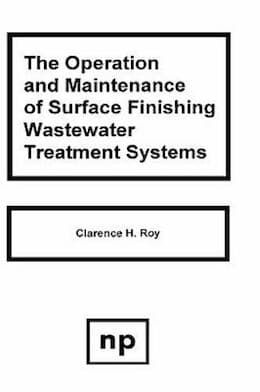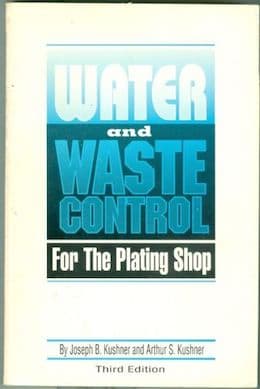
Curated with aloha by
Ted Mooney, P.E. RET

The authoritative public forum
for Metal Finishing 1989-2025

-----
Cyanide plating waste water treatment
2004
Q. Problem with Cyanide Mixture treatment
I have several waste streams of cyanide bearing waste water coming to a common treatment tank. I have the following waste streams:
Copper cyanide rinse water = 300 gallons per day
Bright Alloy Rinse = (Copper Cyanide + Zinc Cyanide mixture) = 300 gallons per week
Acid Gold Rinse = 300 gallons per day.
My problem is I batch treat this waste in a 4500 gallon tank. I use Sodium Hypochlorite solution (Bleach 12%) ⇦ bleach/sodium hypochlorite in bulk on eBay or Amazon [affil links] .
I add bleach to an ORP reading of 750 mv. In the past, a lower ORP level would result in incomplete cyanide destruction. Our goal is to reduce the cyanide to cyanate, adjust the pH and discharge to the POTW.
Normally we have no problem with the cyanide rinse water above treatment to cyanate. The problem arises when a Bright alloy bath is dumped into this mix. The bright Alloy bath is:
NaCN = 3.2 oz/gal
Zn = 0.13 oz/gal
Cu = 0.28 oz/gal
Sn = 0.08 oz/gal
pH = 10.5
This is a complex cyanide bath. When it mixes with the gold rinse we get a tank(4500 gals) of the following
AU - 4.77 mg/l
Cu - 29.3 mg/l
Zn - 2.57 mg/l
CN - 9.13 mg/l after 870 mv contact for 5 days.
When no Gold is in the mix the batch treats in 24 hours with Total cyanide = non-detect. This is verified by outside Lab. We use the EPA method of cook down to test total cyanide. Any suggestion on how to proceed to break this cyanide complex?
Daniel M. ReevesWaste Water Treatment Supervisor - Glendale, Arizona, USA
2004
A. Gold, nickel, and iron cyanide complexes are a lot more difficult to treat, and may not be destroyed by simple chlorination.
By my calculations, there are over 2.5 troy ounces of gold in your 4500 gallon batch. Perhaps it is possible to isolate the gold cyanide flow and treat it with ion exchange before it gets to the batch. Anion resins remove gold cyanide complexes very efficiently, and can hold up to several pounds of gold per cubic foot of resin. They are burned to recover the gold, which destroys the cyanide.
Alternatively, you could add some zinc dust ⇦ this on eBay or Amazon [affil links] to the batch before the chlorination step. The gold will immersion plate on the zinc and be replaced in solution with the more easily treated zinc cyanide.
Good luck, and I hope you can recover the gold!
Lyle Kirmanconsultant - Cleveland Heights, Ohio
Q. We are working with a cyanide plating line and we have seen some issues with the water effluent from the WWTS, we are not able to destroy all the cyanide using bleach at a pH of 9 - 12 and after that we are adding hydrogen peroxide. Is there any suggestion to destroy all the cyanide.
Carlos RodriguezPlating Engineer - Tucker, Georgia, USA
2006
A. Couple of things we need to know to help you. What is the ORP setting (are you using ORP to feed the bleach and peroxide). This will tell us if you are adding sufficient oxidizer to complete the reaction. What is the reaction/ retention time.
Typically with a conventional type of cyanide destruct, which you are doing, problems lie with the reaction times or the ORP settings/ pH settings.
water specialist - Greenville, South Carolina
2006
2006
A. One caveat; make sure your ORP probe is calibrated before you go relying on it. This may be accomplished with quinhydrone. A saturated solution of this is made in pH 4 and 7 buffers. These solutions should have ORP values of +264 and + 84 mV respectively.
Personally, I always batch treated cyanide. The only ORP indicator I ever used was a vial of KI
starch paper
[affil links]. They have the advantage that there is very little that can go wrong with them.

Dave Wichern
Consultant - The Bronx, New York
A. Agree with Gordon and David; better control seems advisable. Unless monitoring free chlorine, a pH of 9-12 seems imprecise - an ORP setpoint too low at pH 9 could be too high at pH 12. Try an ORP of 200 mV* at pH 11-11.5.
Also, the effluent may contain cyanate resulting from the high pH cyanide destruct. Follow the high pH reaction with a cyanate destruct at pH 7.5-8.5 and an ORP >600 mV.*
*Determine ORP settings using the actual controller probes.
- Goleta, California
Rest in peace, Ken. Thank you for your hard work which the finishing world, and we at finishing.com, continue to benefit from.
2006
by Clarence Roy

on AbeBooks
or eBay or
Amazon
(affil links)
A. For rapid cyanide destruction with bleach, a pH of 9 is too low. The pH should be greater than 10.5. At this pH all of the amenable cyanide is destroyed nearly as fast as the bleach is mixed. At lower pH values, the reaction is much slower.
As mentioned above, only cyanides amenable to chlorination are destroyed in this process. Potentially, there may be cyanide-metal complexes, like ferricyanides, that are not destroyed by this process and will still test as "Total Cyanide". If this is your problem, you need to eliminate any contact between iron and cyanide, or use additional treatment of some type.
consultant - Cleveland Heights, Ohio
Reaction between Cyanide and Hypochlorite
Q. Yes, I need to know the reaction ratio between cyanide and bleach. Can anyone provide with the equation that shows the destruction of cyanide using bleach?
Has any of you used a test kit using ampules to test free cyanide in the discharge? Is there any on site test that any of you can recommend for a limit of 0.015 ppm cyanide?
please help!
- Texas City, Texas
2006
by Kushner & Kushner

UTL on eBay
UTL on AbeBooks
on Amazon
(affil links)
A. Hi Carolina. With chlorine gas the reaction is simply:
Cl2 + NaCN + 2 NaOH = NaCNO + 2NaCl +H2O
So with sodium hypochlorite it's probably essentially:
NaOCl + NaCN = NaCNO + NaCl
But the equations have provisos and disclaimers, and hazards abound, so it would be best to view them in context in, for example, the Metal Finishing Guidebook. In the metal finishing industry, where the federal standards are about 20 times less stringent than the number you quote, I found that if the treatment were properly designed, simply testing the effluent for free chlorine with potassium iodide starch paper [affil links] assured compliance. But, sorry, I don't personally know of an easy test for the numbers you want to monitor to.

Ted Mooney, P.E.
Striving to live Aloha
finishing.com - Pine Beach, New Jersey
2006
2006
A. The good news is; yes, you can analyze down to that level with equipment you can buy for about $500. The bad news is; you have to do a cyanide distillation on your wastewater, a process that requires a skilled operator. You can teach yourself how to do it (I did) but it's not a trivial 'add a packet and compare the tube to a color chart' thing at all.
If you don't have the time or personnel to devote to this, send your samples out. If you do, Hach sells a nice set-up.

Dave Wichern
Consultant - The Bronx, New York
2006
A. I have had very good success with Batch treating any and all Cyanide.
pH of 11-11.5 and add bleach until there is a clear and obvious Chlorine residual.
I typically bled my batch through my treatment system after a 3 hour reaction time. (Overkill). Better safe than sorry.
Worst case scenario, Classify it and pay a contractor to remove the waste for you..

Ryan Cook
Toccoa, Georgia
Q. I need some guidance and it seems this could be the right place... I'm a Danish manufacturing engineer student and I'm working on a project for a company that produces waste water containing free cyanide in the amount of 1 - 20 mg/L and at a 100,000 L/day.
The amount needs to be cut down to below 1 mg/L. What is the best method to do this? Can anyone suggest a company that can deliver a treatment equipment/system/solution that can take care of it?
Any help will be most welcome. Thank you in advance!
- Odense, Denmark
October 25, 2008
October 28, 2008
A. Hi, Jakob. The general approach is to use an oxidizing agent: chlorine gas for large installations and sodium hypochlorite for smaller installations. At the correct pH, the oxidizing agent will convert the free cyanide to cyanate rather rapidly. But one needs relevant chemical experience, and usually hands-on training, when proposing something like this because there is the possibility of releasing poisons and toxins. If the cyanide is acidified before complete conversion to cyanate, deadly HCN gas will be released. If the chlorine is excessively acidified, copious amounts of chlorine gas and other toxic gasses will be released. You may also require a secondary treatment where the pH is lowered and additional chlorine is added to convert the cyanate to carbon dioxide and nitrogen. Recognize that adding acid to the solution is a hazard unless you are positive that all the free cyanide has already been destroyed.
Regards,

Ted Mooney, P.E.
Striving to live Aloha
finishing.com - Pine Beach, New Jersey
Treatment of cyanide waste with hydrogen peroxide
Q. Hello to all, I have a question if you can help me:
We treat cyanide waters with hydrogen peroxide. Does anyone know what value of ORP I should have when the oxidizing reaction is about to finish? I worked until now only with free cyanide test kit, but because of the high quantity of CN- in wastewater, sometimes I get errors in results (even with dilution). How should I use ORP when treating CN- with peroxide in order to monitor efficiently the destruction of cyanide?
Sincerely yours,
Sabina
Romania
September 28, 2010
A. Doing a Google search for Cyanide Treatment using peroxide I found:
www.h2o2.com/industrial/applications.aspx?pid=106&name=Cyanide-Treatment
On their web site they have a link to Technical Papers that also might help.
There may also be an alternative method for cleaning up cyanide but I'm still investigating that. Will get back to you when I have completed my research.
Brunswick, Georgia
October 14, 2010
Q. I have a 0.03 discharge limit for cyanide and heard that gluconates can "tie up" the cyanide and create potential discharge problems... Is that true?
Bill MullerGallatin, Tennessee, USA
March 7, 2012
March 15, 2012
A. Gluconates interfere? Never heard of that, though it's possible.
Organic aldehydes are hellacious "killer" interferences with total CN analysis. Not organic acids, though, far as I know.

Dave Wichern
Consultant - The Bronx, New York
A. Hi. Maybe there was a slight misunderstanding. Gluconates are, as Dave notes, organic acid salts, and I believe that they will complex or "tie-up" metals rather than cyanide. Typical waste treatment of alkaline cleaners with high concentrations of gluconates is
1. acidification, followed by
2. adding non-regulated metal salts like magnesium, aluminum, iron, or calcium to use up the gluconate's complexing power, then
3. raising the pH to precipitate the regulated metals.
Regards,

Ted Mooney, P.E.
Striving to live Aloha
finishing.com - Pine Beach, New Jersey
March 24, 2013
Dealing with iron cyanide and total cyanide
March 21, 2013Q. I have cadmium and zinc cyanide bearing wastewater. Calibrated the pH sensor and verified that the ORP sensor would measure 87 mV and 264 mV buffers +- 20 mV.
I ran the cyanide destruction process
1st stage 11.0 pH, 670 mV for 40 min free chlorine at 120 mg/l to 200 mg/l
2nd stage
1st stage 8.13 pH, 900 mV for 90 min free chlorine at 120 mg/l to 200 mg/l
Collected total cyanide 53 ppm and amendable cyanide <20 ppm. Thought we might have complex cyanide with copper or iron.
Tested for iron 28.7 mg/l, Cu = 0.171 mg/l
Does this mean we have iron cyanide complex, if so how do we treat the wastewater and how do we get iron out of the rinses.
Engineering and Wastewater - Placentia, California
A. Hi Bart. I concur with Dave Wichern that the easiest way to check for free cyanide is potassium iodide starch paper [affil links] (the starch paper doesn't actually check for cyanide, it checks for bleach -- but if there is excess bleach and the pH is right there won't be free cyanide), so I would use that to confirm that you destroyed all the free cyanide in the first stage.
You may be able to recognize iron cyanide from the "prussian blue" color, but to my knowledge there is no cheap and practical treatment for it. That's why unlined steel tanks should not be used anymore, nor steel anode baskets. Keep the cyanide from contacting steel, and don't let it mix with nickel or other wastes until the cyanide is destroyed. Better yet, switch to alkaline non-cyanide zinc, and see if you can go with a zinc alloy in place of the cadmium plating.
Luck and Regards,

Ted Mooney, P.E.
Striving to live Aloha
finishing.com - Pine Beach, New Jersey
April 2014
----
Ed. note: For still more on this topic, please also see letter 6852, "Wastewater treatment issues: Cyanide destruction questions".
Q. I have a solution containing 90-110 mg/l of sodium cyanide. I plan on using the process described in the "Managing Cyanide in Metal Finishing" (EPA 625) to oxidize the cyanide into N2 and CO2. I will add sodium hypochlorite to the solution which will start at a pH of 10.5 until the ORP reads +325-400 mv after 20 minutes. The second step calls for lowering the pH to 8.5 but does not specify how. Can sodium bicarbonate be used? If not, which dilute acid should be used (I have phosphoric and citric on site)? The second stage after the pH is reduced to 8.5 is to add more sodium hypochlorite until a ORP of +600-800 mv is read after 60 minutes. Are any problems with this process visible to anyone??
Cameron kivelaProcess engineer - Boulder, Colorado, usa
April 9, 2014
April 17, 2014
A. A saturated solution of bicarb has a pH of 8.3, if memory serves. I guess it would work but it would take a lot. I used to simply use sulfuric acid. Phosphoric would work, but might generate excess solids if certain anions are present. Just make sure all the "free" cyanide is gone before acidifying. Sometimes, sparingly soluble CN compounds will precipitate and settle to the bottom. Make sure that that's not the case.
The cyanate oxidation step is not strictly required. It will spontaneously break down into ammonia and carbonate. NH3 might cause problems if you have a lot of copper and or nickel.

Dave Wichern
Consultant - The Bronx, New York
A. If you treat the cyanides which are amenable with NaClO, you can then proceed with metals precipitation which will lower your total CN measurement to less than .5 ppm; any sludge generated will contain metals and cyanide
Mike ShoupMarch 18, 2016
CN increases instead of decreasing after chlorination
Q. I'm having cyanide concentrations in wastewater samples as 1.5 g/l in form of KCN tested by auto titrator. But when I treat it with hypochlorite, the concentration gets increased rather than getting decreased, although I maintain the ORP levels to 250 for first stage and pH to 10.5.
What improvements am I required to do, or what other treatment options would be available instead of this treatment?
vanashri limayeAugust 30, 2016
August 30, 2016
A. 1.5 g/l is pretty high for chlorination. I imagine you get a lot of cyanogen chloride offgassing.
You might try 50% hydrogen peroxide. Lower the pH with sodium bicarbonate to less than 11, add a 1/2 pound of copper sulphate, then add peroxide until you see a color change to light green. It's good to use a tank with plenty of freeboard, because at the end, all the excess peroxide autolyzes and if the tank is too full it will go all over the place.

Dave Wichern
Consultant - The Bronx, New York
Q. Thanks for the prompt reply; it will surely be of great help. But I would like to ask will it create HCN at low pH ... as according to literature I came across that at lower pH HCN may vaporize? So is it possible practically too? And what shall be the retention time kept for H202 process? And here we have 30% H202 available so will it be ok if I use 30% instead of 50?
And is ozonation or any other such treatment possible in such high concentrations along with H202?
Thanx again.
August 30, 2016
A. Sure, it's fine to use 30% H2O2. It will just take more.
I did this treatment many times and never had a problem with HCN evolution. That's why you use bicarbonate, no matter how much is added the pH will not go below about 8. What might be a problem is the mist generated by O2 bubbles breaking the surface. I'd wear a cartridge respirator, never had a problem.
The residence time will vary depending on the metals present. I used to treat a 2,000 gallon batch of zinc cyanide waste with 1 - 1.5 g/l CN in about two hours.
Ozone is a great help, though to have it do the whole job would take a heck of a lot. Where it would be useful is in the finish, because I was never able to get the CN under about 50 mg/l with peroxide alone. I'd have to chlorinate, which has its disadvantages. It generates trihalomethanes by reacting with the brighteners and what not in the waste.
There's a good test for excess peroxide. Dissolve as much TiO2 in conc. H2SO4 as will go. Dilute this 1:4 with H2O. Combine 2 ml of this with 10 ml of the waste you're processing. A yellow color will develop, proportional to the H2O2 concentration. This is the pertitanic acid method, for details see Snell and Snell's "Colorimetric Methods of Analysis." It's from 1952, it's an oldie but a goodie.
Good luck! Be careful.

Dave Wichern
Consultant - The Bronx, New York
August 31, 2016
Q. Thank you very much sir for your great help indeed it worked but I faced some problems though. I experimented according to your H2O2 guidelines ,and that did decrease the cyanide content to 'not detectable' on initial trial and on second trial 0.31, 0.13 g/l were obtained.
But I would like to ask that when CuSO4 was added precipitates were formed (with light green color pre H2O2 addition), and then I added H2O2, but those ppts were not soluble and on taking the samples after half an hour or so, as it contained some ppts might be I obtained higher concentration -- can this be the case for higher concentration of cyanides? If yes, then ppt must not contain free cyanides, a lot of confusion has started in my mind, please do help me out. And is it possible that H2O2 may get evolved (due to its half life) not completing the reaction? Is it needed to increase its solubility by adding anything?
Vanashri Limaye [returning]September 1, 2016
A. Dear Friends.
Hi
First we should attend to the pH value of the cyanide waste water. It should be maintained at 9-11 (preferably 10 ) so that the ORP electrode shows the correct value of desired ORP. The wrong pH will void the electrode function. So first adjust pH by adding NaOH (dilute) or mix the alkaline degreasing with your wastewater.
Then add calcium hypochlorite or use ozonation instruments to bring the negative/low ORP to +500. Please note that if you use Chlorine compounds, you should allow delays in injection periods. This way the Chlorine has enough time to react with complexes; otherwise the Cl level will be in excess and the output water look yellowish with bad chlorine smell. After delays and injections you will have the carbonate of the metals (Cu, Zn) and some sludge.
Then you can use milk of lime to raise the pH to 10-12 to precipitate all metal salts. Use some aeration instrument such as blowers to remove excess chlorine and also mix the lime milk with wastewater. After secondary pH control and some water polishing you can reuse it.
Please note: Safety first.

Alireza Reyhan
- Istanbul, Turkey
May 30, 2017
Cyanide reduction using sodium hypochlorite
July 10, 2018Q. Hi All,
I am hoping someone will be able to help with a bit of an issue I am having.
I have a process that uses cyanate salts, sodium and potassium cyanate, which when in process convert to cyanides. These salts never get released to the drains directly, however there can be a little bit of carry over into the wash waters and eventually into our effluent stream. I have been looking to reduce the cyanide using sodium hypochlorite, the issue that I am having is finding out how much hypochlorite we would need to reduce a certain amount of cyanide, for example:
The effluent treatment tank is approximately 3500 liters, and the concentration of cyanide in the tank is 5 mg/l.
ACRONYMS:
WAD = weak acid dissociables
SAD = strong acid dissociables
How much hypochlorite would it take to remove the cyanide? and how do you calculate it? Will hypochlorite remove WAD and total cyanide or just free cyanide?
Also, if my understanding is correct, the hypochlorite would turn the cyanide into cyanate, is there anyway to fully remove the cyanate as well?
If both removing cyanide and removing cyanate could be answered separately would be great, I'm not 100% sure what we have to remove yet so I could do with knowing both scenarios.
A. Hi James. We appended your inquiry to one of many previous threads on the subject. The formula you need is probably:
NaOCl + NaCN = NaCNO + NaCl
…but counting on stoichiometric relationships is tricky because that one remaining molecule of NaOCl in the upper right far corner of the tank may never contact the one remaining molecule of NaCN in the lower left near corner, or it may be lost to reacting with some stray organic. So you always need some excess :-)
Hypochlorite will oxidize cyanate but it is usually done as a second stage and requires several times as much hypochlorite and a lower pH. The Metal Finishing Guidebook offers that info.
Chlorination will remove cyanides "amenable to chlorination" and that generally includes WADs but generally not SADs.
Regards,

Ted Mooney, P.E. RET
Striving to live Aloha
finishing.com - Pine Beach, New Jersey
July 2018
sometimes on
AbeBooks or Amazon
(affil links)

free pdf is currently available from academia.edu
Copper Cyanide waste water treatment
Q. We use sodium hypochlorite for the treatment of copper Cyanide in waste water at 11 pH but after treatment Cyanide concentration is satisfactory but copper is high. How do we reduce copper concentration? Please help.
Jagdish YadavOctober 28, 2018
A. Hi Jagdish. Sodium hypochlorite destroys cyanide but the copper must be physically removed. Take a bit of your treated wastewater, simply pour it through a Whatman filter, and tell us what the copper concentration of the filtrate is vs. what you need to achieve. Then we can continue ...
Regards,

Ted Mooney, P.E. RET
Striving to live Aloha
finishing.com - Pine Beach, New Jersey
October 2018
Q. After pouring through Whatman filter, copper concentration 0.6 mg/ltr -- this is satisfactory result; but before filtration it was 5 mg/ltr, our limit is below 3 mg/ltr. We are doing batch type treatment how do we reduce excess copper concentration below 3 mg/ltr in our treatment plant.
Jagdish Yadav [returning]October 31, 2018
A. Hi Jagdish. There is no way to destroy copper, all you can do is separate it from your discharge water and deal with it. Your filtration test demonstrated that your chemical treatment is sufficient. But now you must remove the copper precipitate from the wastewater. This is typically done by adding a polyelectrolyte flocculation agent and passing the wastewater thru a large lamella or tube-settler clarifier so the copper has time to settle -- no matter how you do it, it takes times for the settling. Then you must concentrate the copper-bearing sludge with a filter and have it legally disposed of. Alternately you can directly filter the waste, but you probably have so much water to deal with that this is problematic. Good luck.
Regards,

Ted Mooney, P.E. RET
Striving to live Aloha
finishing.com - Pine Beach, New Jersey
October 2018
Q, A, or Comment on THIS thread -or- Start a NEW Thread
